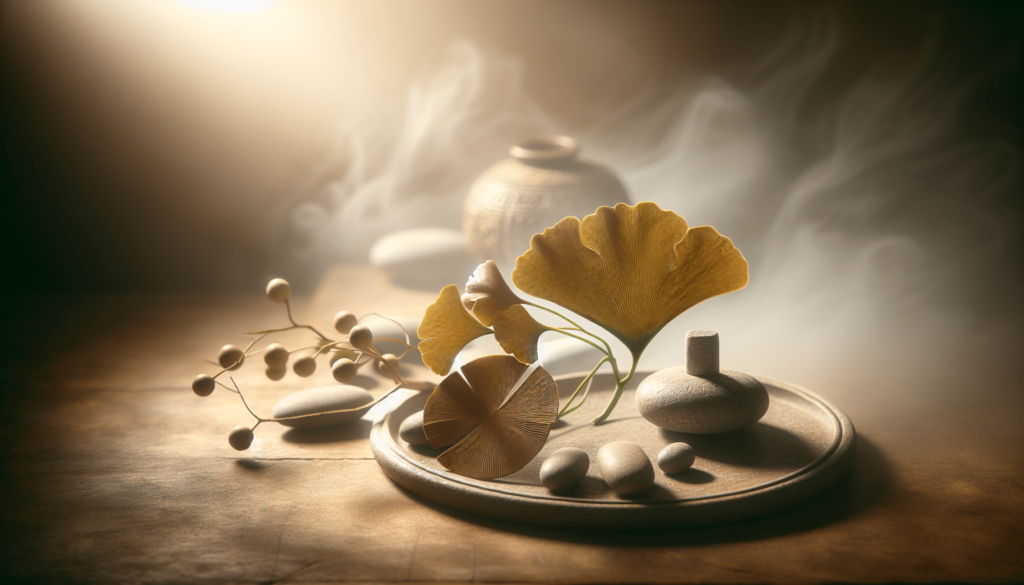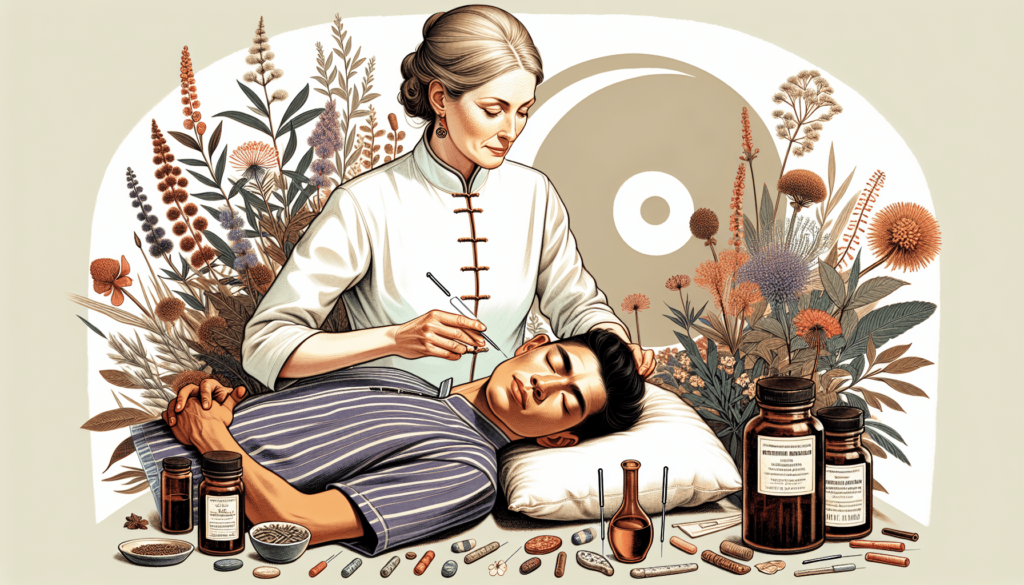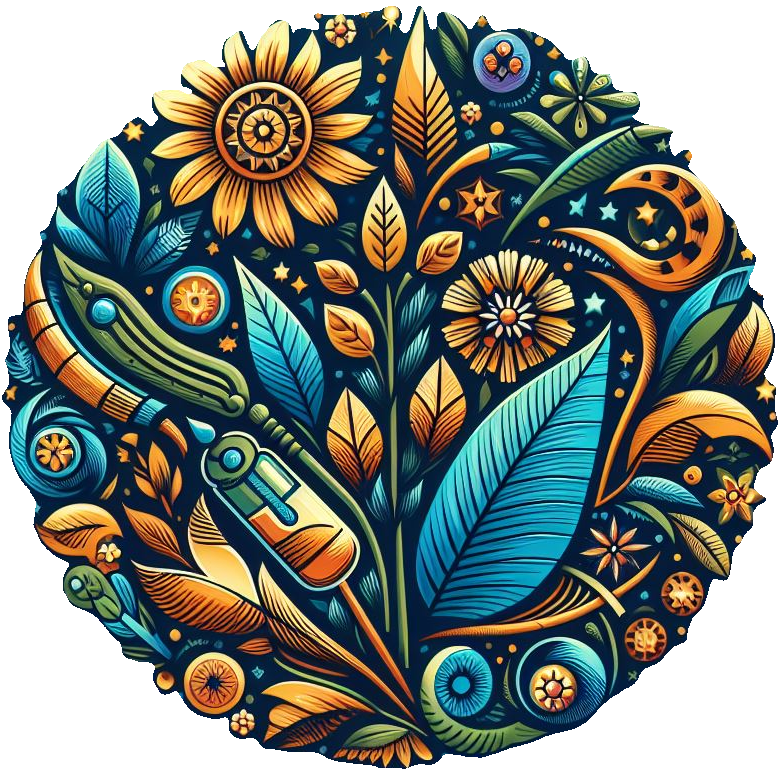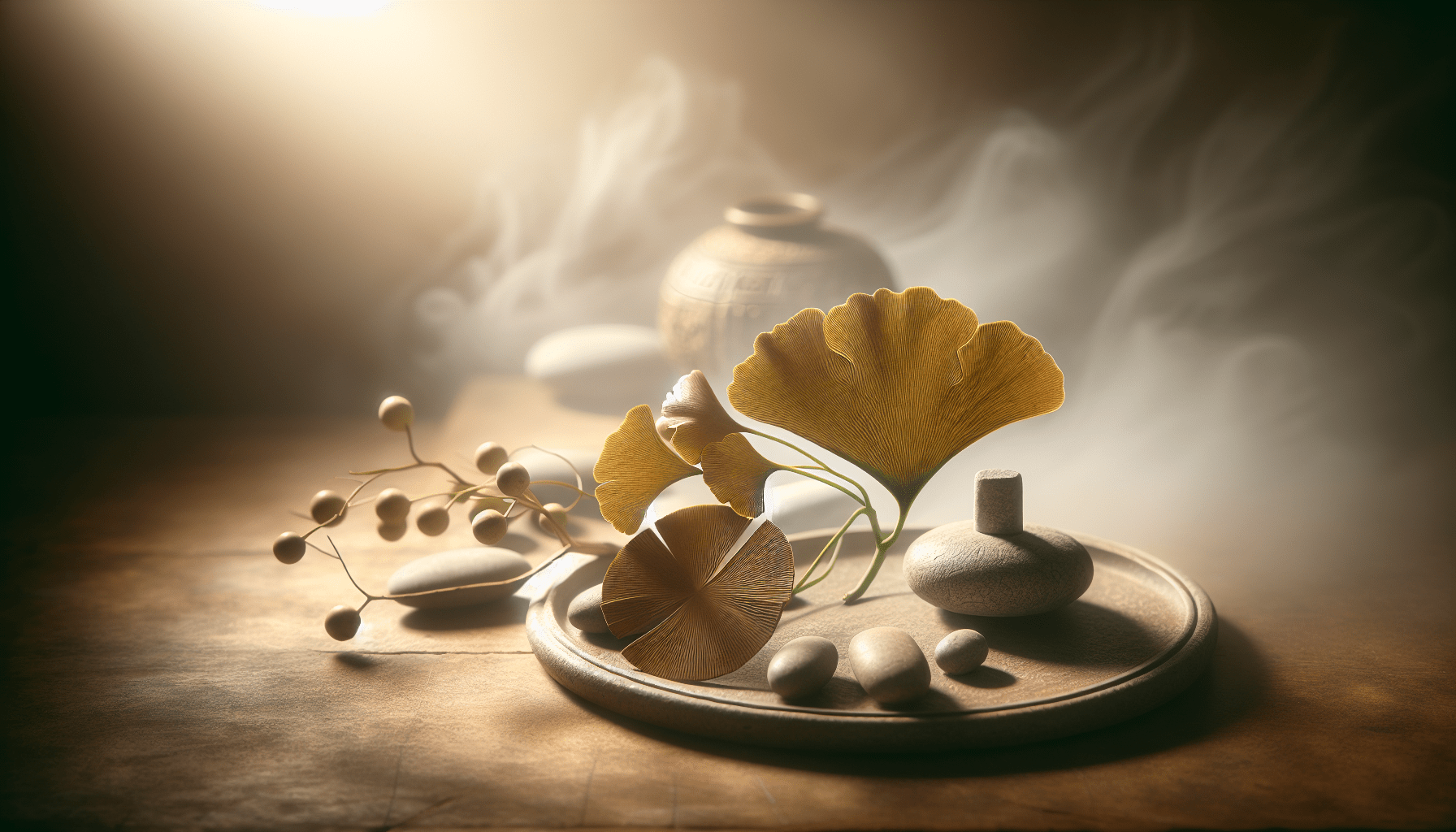So, you’re feeling anxious and looking for some natural ways to manage it? Well, look no further! In this article, we’ll be exploring Traditional Chinese Medicine (TCM) approaches that have been proven to effectively alleviate anxiety symptoms. Forget about prescription medications and their potential side effects – TCM offers a holistic and personalized approach to address the root causes of anxiety and restore balance to your mind and body. From acupuncture to herbal remedies, we’ll be uncovering the ancient wisdom and techniques that have been used for centuries to promote mental well-being. Get ready to discover a whole new way to manage your anxiety, the TCM way!

Acupuncture
Acupuncture is a key component of Traditional Chinese Medicine (TCM) that involves the insertion of fine needles into specific points on the body. It is believed to help restore the flow of energy, known as Qi, in the body. Acupuncture has gained popularity as a natural and holistic approach to addressing various health concerns, including anxiety.
Overview of Acupuncture
Originating in ancient China, acupuncture has been practiced for thousands of years. According to TCM principles, anxiety is often attributed to an imbalance or blockage of energy in the body. By inserting needles into specific acupuncture points, an acupuncturist aims to stimulate the body’s self-healing mechanisms and restore equilibrium.
How Acupuncture Can Help with Anxiety
Acupuncture has been shown to have a calming and soothing effect on the nervous system. The process of inserting needles triggers the release of endorphins, the body’s natural painkillers, and serotonin, a neurotransmitter linked to mood regulation. These chemical changes promote relaxation, reduce stress, and alleviate anxiety symptoms.
Specific Acupuncture Points for Anxiety
Certain acupuncture points are known to be particularly effective in addressing anxiety. The acupuncturist may target points such as the Shenmen (located on the ear), Yin Tang (between the eyebrows), and Pericardium 6 (on the wrist). These points are believed to help regulate emotions, calm the mind, and promote a sense of well-being.
Duration and Frequency of Acupuncture Sessions
The duration and frequency of acupuncture sessions for anxiety may vary depending on the individual’s condition. Generally, a series of treatments is recommended to achieve optimal results. Acupuncture sessions for anxiety typically last around 30 minutes to an hour. The frequency can range from once a week to a few times per week, depending on the severity of symptoms and the acupuncturist’s recommendation.
Herbal Medicine
Herbal medicine is an integral part of TCM that utilizes various plant-based remedies to support health and well-being. When it comes to managing anxiety, specific herbs have been traditionally used to promote relaxation and balance.
Introduction to Herbal Medicine in Traditional Chinese Medicine
In TCM, herbal medicine is seen as a way to restore harmony and balance within the body. Herbal formulas are carefully crafted to address individual symptoms and imbalances. The use of herbs in TCM takes into consideration the person as a whole, focusing not only on relieving symptoms but also on addressing the root cause of the anxiety.
Herbs for Anxiety Relief
Several herbs have shown potential in providing relief for anxiety symptoms. Some commonly used herbs include Bai He (Lily Bulb), Huang Qin (Chinese Skullcap), and Yuan Zhi (Polygala Root). These herbs are believed to have calming properties, nourish the nervous system, and help regulate emotions.
Preparation and Administration of Herbal Medicine
Herbal medicine is usually prescribed in the form of a customized herbal formula, tailored to the individual’s specific needs. The herbs can be consumed as decoctions (boiling herbs to extract their essence), powders, pills, or tinctures. The preparation method and dosage are determined by a qualified TCM practitioner based on the individual’s condition and constitution.
Potential Side Effects and Safety Considerations
While herbal medicine is generally considered safe when prescribed by a qualified practitioner, it is essential to be aware of potential side effects and safety considerations. Some herbs may interact with medications or have contraindications for certain medical conditions. It is crucial to consult with a knowledgeable TCM practitioner and inform them of any existing health conditions or medications before starting herbal treatment.
Moxibustion
Moxibustion is a TCM technique that involves burning mugwort (Artemisia vulgaris) near specific acupuncture points on the body. It is used to promote healing and enhance the flow of Qi and blood.
Explanation of Moxibustion
Mugwort leaves are dried and processed into a material called moxa. During moxibustion, a small cone or stick of moxa is ignited and held near the skin without direct contact. The radiant heat stimulates the acupuncture points and meridians, providing therapeutic benefits.
Benefits of Moxibustion for Anxiety
Moxibustion is believed to have a significant calming effect on the nervous system, making it a valuable technique for managing anxiety. The gentle heat from the moxa can help relax muscle tension, improve blood circulation, and activate the body’s natural healing response. By targeting specific acupuncture points, moxibustion aims to restore balance and reduce anxiety symptoms.
Procedure and Technique for Moxibustion
Moxibustion can be performed in various ways, including direct or indirect methods. In direct moxibustion, a small piece of moxa is placed directly on the acupuncture point and then ignited, producing a localized heat sensation. In indirect moxibustion, a practitioner holds a lit moxa stick near the acupuncture point without contact. The technique used will depend on the individual’s condition and the practitioner’s expertise.
Precautions and Contraindications for Moxibustion
As with any TCM technique, moxibustion has precautions and contraindications to ensure safe and effective treatment. Moxibustion should be avoided for individuals with sensitive or allergic skin conditions, open wounds, or reduced sensitivity to heat. Pregnant women should consult with a qualified practitioner before considering moxibustion, as certain acupuncture points are contraindicated during pregnancy.
Cupping Therapy
Cupping therapy is a traditional TCM technique in which heated cups are placed on the skin to create suction, promoting blood flow and stimulating the body’s natural healing response.
Overview of Cupping Therapy
Cupping therapy involves placing cups made of glass, bamboo, or plastic on specific areas of the body. The cups create a vacuum effect, drawing the skin and underlying tissues into the cups. This technique is used to alleviate muscle tension, reduce pain, and improve overall well-being.
How Cupping Therapy Can Relieve Anxiety
Cupping therapy is believed to promote the flow of Qi and blood in the body, helping to relieve stagnation or blockages that may contribute to anxiety. By enhancing blood circulation and releasing muscle tension, cupping therapy can promote relaxation, reduce stress, and alleviate anxiety symptoms.
Types of Cupping Techniques
There are various cupping techniques used in TCM, including stationary cupping, sliding cupping, and flash cupping. Stationary cupping involves placing cups in specific locations for a designated period. Sliding cupping involves applying oil to the skin and moving the cups along specific meridians or muscle groups. Flash cupping involves quickly applying and removing cups in a rhythmic manner.
Proper Application and Safety Measures
Cupping therapy should always be performed by a qualified and experienced practitioner to ensure proper application and safety. The cups should be carefully sterilized, and the duration and intensity of the therapy should be tailored to the individual’s condition and sensitivity. It is essential to communicate any discomfort or unusual sensations during the session to the practitioner for adjustments as needed.
Dietary Therapy
Dietary therapy in TCM emphasizes the role of food in promoting balance and harmony within the body. Making specific dietary choices can help support the body’s natural ability to manage anxiety.
Role of Diet in Traditional Chinese Medicine
In TCM, the choice of foods is believed to have a direct impact on the body’s Qi, Yin, Yang, and overall well-being. Foods are categorized based on their energetic properties and the effects they have on the body. By incorporating foods that promote calmness, nourish the nervous system, and support digestion, dietary therapy aims to address the root causes of anxiety.
Foods and Beverages to Reduce Anxiety
Some foods known for their anxiety-reducing properties in TCM include chamomile tea, green leafy vegetables, nourishing soups, whole grains, and foods rich in omega-3 fatty acids. Chamomile tea, for example, has a calming effect on the nervous system and can help promote relaxation. Leafy greens, such as spinach and kale, provide essential nutrients for overall brain health.

Incorporating Yin and Yang Balance in the Diet
In TCM, maintaining a balance between Yin and Yang is crucial for optimal health. Yin represents the cooler, nourishing aspects, while Yang represents the warmer, active aspects. Balancing Yin and Yang in the diet can be achieved by incorporating a variety of foods and cooking methods. For example, adding cooling foods like cucumber or watermelon to your meals can help balance excess heat or Yang energy.
Guidelines for a Balanced Diet
Incorporating a balanced diet in TCM involves following some general guidelines. These include eating a variety of fresh and seasonal fruits and vegetables, choosing whole grains over refined grains, consuming moderate amounts of animal protein, and avoiding excessive consumption of processed foods and refined sugars. It is also essential to eat mindfully, savoring each bite, and maintaining a relaxed eating environment.
Tai Chi and Qigong
Tai Chi and Qigong are ancient Chinese practices that combine gentle movements, breath control, and meditative techniques. These mind-body exercises are known for their mental, physical, and emotional benefits, including anxiety management.
Understanding Tai Chi and Qigong
Tai Chi and Qigong involve slow, flowing movements, coordinated with deep breathing and focused intention. These practices are based on the principles of balancing Yin and Yang, cultivating Qi, and improving the flow of energy in the body. They can be practiced standing or sitting, making them accessible to people of all ages and fitness levels.
Benefits of Tai Chi and Qigong for Anxiety
Regular practice of Tai Chi and Qigong has been shown to reduce anxiety symptoms by promoting relaxation, improving mental clarity, and enhancing overall well-being. The gentle movements and deep breathing help calm the nervous system, reduce muscle tension, and cultivate a heightened state of mindfulness.
Specific Techniques for Anxiety Management
Tai Chi and Qigong offer specific techniques that can be used to manage anxiety. Techniques such as “Waving Hands in the Clouds” and “Holding the Balloon” focus on gentle movements and smooth transitions, allowing for deep relaxation and a sense of inner peace. Incorporating these techniques into a regular practice can help individuals develop a greater sense of self-awareness and emotional resilience.
Finding Qualified Instructors
To learn Tai Chi and Qigong for anxiety management, it is important to find qualified instructors who can guide and teach the correct techniques. Look for instructors who have received certification and have experience in teaching these practices. They should understand the principles of TCM and be able to adapt the exercises to suit individual needs and abilities.
Lifestyle Adjustments
In TCM, lifestyle plays a crucial role in maintaining overall well-being. Making specific adjustments to your daily routine and habits can have a significant impact on anxiety management.
Importance of Lifestyle in TCM
TCM recognizes that a healthy lifestyle is vital for promoting balance and preventing illness. Factors such as stress levels, sleep patterns, physical activity, and self-care practices all influence the body’s energy flow and overall health. By making positive lifestyle adjustments, individuals can create a supportive environment for overall well-being and anxiety management.
Stress Management Techniques
Effective stress management can help reduce anxiety symptoms. Practices such as meditation, deep breathing exercises, journaling, and engaging in hobbies or activities you enjoy can all contribute to stress reduction. Identifying and addressing sources of stress in your life and finding healthy coping mechanisms can significantly impact anxiety levels.
Sleep and Rest Recommendations
Quality sleep and rest are essential for rejuvenating the body and mind. Creating a sleep routine that prioritizes regular sleep times, a comfortable sleep environment, and relaxation techniques before bed can improve sleep quality. It is also crucial to allow oneself adequate rest and relaxation throughout the day, especially during times of increased stress or anxiety.
Exercise and Physical Activity
Engaging in regular physical activity is beneficial for managing anxiety. Exercise helps release endorphins, the body’s natural mood boosters. Activities such as walking, yoga, swimming, or dancing can help relieve tension, improve circulation, and promote a sense of overall well-being. Finding activities that are enjoyable and sustainable can make exercise a positive addition to anxiety management.
Breathing Exercises
Deep breathing exercises are an integral part of TCM and can be used as standalone relaxation techniques or incorporated into other practices. Breathing exercises can help calm the mind, reduce anxiety, and restore a sense of balance within the body.
Role of Breath in Chinese Medicine
In TCM, breath is seen as the bridge between the physical body and the mind. The quality of breath directly affects the flow of Qi and blood in the body. By focusing on the breath and regulating its depth and rhythm, individuals can influence their energy flow and promote relaxation.
Breathing Techniques for Anxiety Relief
Several breathing techniques can be used for anxiety relief. One commonly practiced technique is deep abdominal breathing, also known as diaphragmatic breathing. This involves inhaling deeply through the nose, filling the abdomen with air, and exhaling slowly through the mouth. Other techniques, such as alternate nostril breathing or box breathing, can also help regulate the breath and reduce anxiety.
Practicing Deep Abdominal Breathing
To practice deep abdominal breathing, find a comfortable seated or lying position. Place one hand on the chest and the other on the abdomen. Inhale deeply through the nose, feeling the abdomen rise as it fills with air. Exhale slowly through the mouth, allowing the abdomen to fall. Repeat this process, focusing on the breath and releasing any tension or anxiety with each exhalation.
Incorporating Breathing Exercises into Daily Routine
Breathing exercises can be incorporated into daily routines to help manage anxiety. Setting aside a few minutes each day for focused breathing can provide a sense of calm and help prevent feelings of stress from escalating. Breathing exercises can be done anytime, anywhere, making them accessible tools for anxiety management.
Emotional and Mental Health Support
In TCM, emotional and mental well-being are considered essential aspects of overall health. Various techniques and practices can be utilized to support emotional balance and provide additional support in managing anxiety.
Emphasis on Emotional Well-being
TCM recognizes the close connection between emotions and physical health. Unresolved emotions or ongoing emotional stress can contribute to imbalances in the body, including anxiety. Taking steps to support emotional well-being is an integral part of managing anxiety holistically.
Mindfulness and Meditation Practices
Mindfulness and meditation practices are effective tools for cultivating self-awareness and managing anxiety. These practices involve paying attention to the present moment, observing thoughts and sensations without judgment, and cultivating a sense of calm and relaxation. Regular meditation or mindfulness sessions can reduce anxiety, improve concentration, and promote a greater sense of inner peace.
Exploring Emotional Triggers and Patterns
Understanding and exploring emotional triggers and patterns can provide valuable insights into anxiety management. By recognizing and addressing underlying emotional causes of anxiety, individuals can make positive changes in their lives and develop healthier coping mechanisms. Journaling, therapy, or talking to a trusted friend or counselor can be helpful in this process.
Professional Support and Counseling
Seeking professional support and counseling can provide valuable guidance and a safe space to explore anxiety and related emotional concerns. TCM practitioners, therapists, and counselors who are familiar with holistic approaches can offer personalized recommendations and support for managing anxiety. It is important to find a qualified professional who understands both the physical and emotional aspects of anxiety management.
Acupressure
Acupressure is a technique used in TCM that involves applying pressure to specific acupuncture points on the body. It is a non-invasive alternative to acupuncture and can be done by oneself or with the help of a trained practitioner.
Introduction to Acupressure
Acupressure works on the same principles as acupuncture, focusing on stimulating specific points to promote balance and alleviate symptoms. Instead of needles, acupressure uses fingers, hands, or specialized tools to apply pressure to the acupuncture points. This pressure helps activate the body’s natural healing abilities and restore harmony.
Pressure Points for Anxiety Relief
Acupressure points that are commonly used for anxiety relief include Shenmen (located on the ear), Pericardium 6 (on the wrist), and Anmian (behind the ear). Applying gentle but firm pressure to these points can help calm the mind, reduce stress, and promote relaxation.
Techniques for Self-Acupressure
Self-acupressure can be performed by using your fingers or specialized acupressure tools to apply pressure to the desired points. Begin by locating the chosen point using a diagram or guidance from a qualified practitioner. Apply firm but comfortable pressure to the point, either in a circular motion or by holding the pressure for a few minutes. Repeat the process for each desired point.
Integration with Other TCM Approaches
Acupressure can be integrated with other TCM approaches, such as herbal medicine or dietary therapy, to provide a comprehensive approach to anxiety management. Combining acupressure with these other techniques can enhance the overall effectiveness and synergy of the treatment plan. It is always recommended to consult with a qualified TCM practitioner for guidance and personalized recommendations.
In conclusion, Traditional Chinese Medicine offers a wide range of approaches for managing anxiety. From acupuncture and herbal medicine to moxibustion, cupping therapy, and dietary modifications, TCM aims to restore balance and promote overall well-being. Practices such as Tai Chi and Qigong, breathing exercises, and emotional support techniques further contribute to anxiety management. By incorporating these various approaches into your lifestyle and seeking the guidance of qualified practitioners, you can cultivate a holistic path toward anxiety relief and improved emotional well-being.

